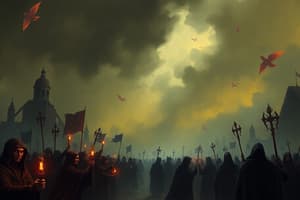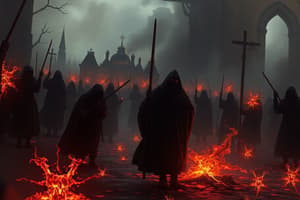Podcast
Questions and Answers
What was the most commonly noted symptom of the Black Death?
What was the most commonly noted symptom of the Black Death?
- Fever
- Respiratory problems
- Headaches
- Appearance of buboes in groin, neck, and armpits (correct)
What is the least common form of the Black Death?
What is the least common form of the Black Death?
- Pneumonic plague
- Bubonic plague
- Septicaemic plague (correct)
- All forms are equally common
Where did the Black Death originate according to genetic analysis?
Where did the Black Death originate according to genetic analysis?
- In China
- In the Tian Shan mountains (correct)
- In Europe
- Near the Caspian Sea
How did the Black Death spread to Europe?
How did the Black Death spread to Europe?
What was the death toll of the Black Death?
What was the death toll of the Black Death?
What was the mortality rate of the Black Death in the 14th century compared to 20th-century outbreaks of Y. pestis plague?
What was the mortality rate of the Black Death in the 14th century compared to 20th-century outbreaks of Y. pestis plague?
What was the impact of the Black Death on European society?
What was the impact of the Black Death on European society?
What is the origin of the word 'quarantine'?
What is the origin of the word 'quarantine'?
When did the third plague pandemic occur and how many people did it kill in India alone?
When did the third plague pandemic occur and how many people did it kill in India alone?
Flashcards
What was the cause of the Black Death?
What was the cause of the Black Death?
Yersinia pestis is a bacterial species that causes bubonic plague. It was the culprit behind the devastating pandemic known as the Black Death.
Where did the Black Death originate?
Where did the Black Death originate?
The Black Death originated in Central Asia around 2,600 years ago. It is believed to have emerged near the Tian Shan mountains, the border between Kyrgyzstan and China.
How was the Black Death primarily transmitted?
How was the Black Death primarily transmitted?
The plague spread from a rat to person via fleas. This is a common mode of transmission during outbreaks.
How did the Black Death reach Europe?
How did the Black Death reach Europe?
Signup and view all the flashcards
What were the symptoms of the Black Death?
What were the symptoms of the Black Death?
Signup and view all the flashcards
What were the consequences of the Black Death in Europe?
What were the consequences of the Black Death in Europe?
Signup and view all the flashcards
How did the Black Death impact the economy and society?
How did the Black Death impact the economy and society?
Signup and view all the flashcards
What major change resulted from the response to the Black Death?
What major change resulted from the response to the Black Death?
Signup and view all the flashcards
How significant was the Black Death?
How significant was the Black Death?
Signup and view all the flashcards
Study Notes
The Black Death was a bubonic plague pandemic that occurred in Western Eurasia and North Africa from 1346 to 1353, causing the deaths of 75-200 million people, peaking in Europe from 1347 to 1351. It is the most fatal pandemic recorded in human history. The pandemic was caused by the bacterium Yersinia pestis spread by fleas, but during the Black Death, it probably also took a secondary form, spread by person-to-person contact via aerosols, causing pneumonic plague. The origin of the Black Death is disputed, and genetic analysis points to the evolution of Yersinia pestis in the Tian Shan mountains on the border between Kyrgyzstan and China 2,600 years ago. The Black Death was the second great natural disaster to strike Europe during the Late Middle Ages. The pandemic was the beginning of the second plague pandemic and created religious, social, and economic upheavals, with profound effects on the course of European history. The pandemic was first introduced to Europe during the siege of the Genoese trading port of Kaffa in Crimea by the Golden Horde army of Jani Beg in 1347. The Black Death killed 30 percent to 60 percent of the European population, as well as about one-third of the population of the Middle East. The phrase 'black death' was not used to describe the plague pandemic in English until the 1750s. Due to climate change in Asia, rodents began to flee the dried-out grasslands to more populated areas, spreading the disease. The role of Y. pestis was confirmed with genetic evidence derived from Black Death victims. Mathematical modelling is used to match the spreading patterns and the means of transmission. A research in 2018 challenged the popular hypothesis that "infected rats died, their flea parasites could have jumped from the recently dead rat hosts to humans" and suggested an alternative model in which "the disease was spread from human fleas and body lice to other people".The Black Death: Origins, Transmission, Symptoms, and Consequences
Origins:
- Yersinia pestis, the bacteria responsible for the Black Death, evolved in or near China over 2,600 years ago.
- The Silk Road had already been disrupted before the spread of the Black Death, making spread of the plague less likely.
- The Black Death may have originated in the nearby plague focus on the northwestern shore of the Caspian Sea.
Transmission:
- Lack of hygiene facilitated the spread of transmissible disease.
- Pigs, cattle, chickens, geese, goats and horses roamed the streets of medieval cities.
- The disease was reportedly first introduced to Europe via Genoese traders from their port city of Kaffa in the Crimea in 1347.
- From Italy, the disease spread northwest across Europe, striking France, Spain, Portugal, and England by June 1348, then spread east and north through Germany, Scotland and Scandinavia from 1348 to 1350.
Symptoms:
- Symptoms of the disease include fever, headaches, painful aching joints, nausea and vomiting, and a general feeling of malaise.
- The most commonly noted symptom was the appearance of buboes (or gavocciolos) in the groin, neck and armpits, which oozed pus and bled when opened.
- A distinct form of the disease, pneumonic plague, infected the lungs and led to respiratory problems.
- Septicaemic plague is the least common of the three forms, with a mortality rate near 100%.
Consequences:
-
There are no exact figures for the death toll; the rate varied widely by locality.
-
It killed some 75 to 200 million people in Eurasia.
-
The mortality rate of the Black Death in the 14th century was far greater than the worst 20th-century outbreaks of Y. pestis plague.
-
The overwhelming number of deceased bodies produced by the Black Death caused the necessity of mass burial sites in Europe.The Black Death: Impact and Recurrences
-
The Black Death killed 45-50% of the European population, and possibly as much as 60%.
-
The disease spread so rapidly that around a third of the European population had already died by 1348.
-
In crowded cities, as much as 50% of the population died, with half of Paris' population of 100,000 people dying.
-
The pandemic disproportionately affected the poorest people, who were in worse physical condition than the wealthier citizens.
-
With such a large population decline, wages soared in response to a labor shortage, but inflation caused a reduction in real incomes for some laborers, artisans, and craftsmen.
-
The pandemic may have led to the Little Ice Age due to the innumerable deaths cooling the climate by freeing up land and triggering reforestation.
-
The Black Death led to an increase in religious fervor and fanaticism, with some Europeans blaming Jews, friars, foreigners, beggars, pilgrims, lepers, and Romani for the crisis.
-
The pandemic completely restructured both religion and political forces, with survivors turning to other forms of spirituality and the power dynamics of the fiefs and city-states crumbling.
-
The word "quarantine" has its roots in this period, with a thirty-day isolation period implemented in the city-state of Ragusa (modern Dubrovnik, Croatia) in 1377 for new arrivals to the city from plague-affected areas.
-
The plague repeatedly returned to haunt Europe and the Mediterranean throughout the 14th to 17th centuries.
-
The third plague pandemic (1855–1859) started in China in the mid-19th century, spreading to all inhabited continents and killing 10 million people in India alone.
-
Modern treatment methods include insecticides, antibiotics, and a plague vaccine, but a drug-resistant form of the bacterium was found in Madagascar in 1995, and outbreaks continue to occur, with the deadliest outbreak in modern times hitting Madagascar in 2017.
Studying That Suits You
Use AI to generate personalized quizzes and flashcards to suit your learning preferences.





